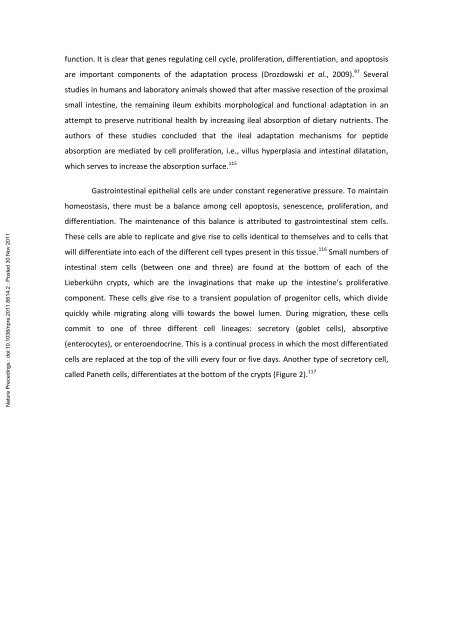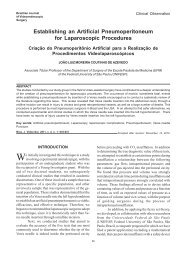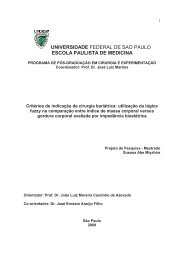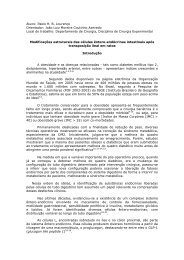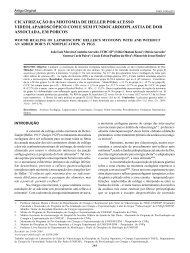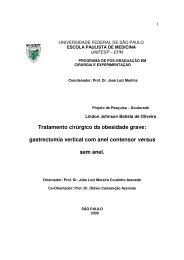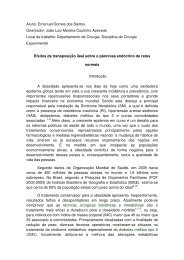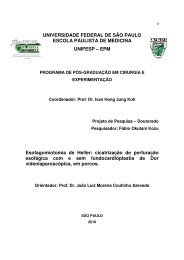Isolated ileal interposition in enteroendocrine L cells differentiation
Isolated ileal interposition in enteroendocrine L cells differentiation
Isolated ileal interposition in enteroendocrine L cells differentiation
You also want an ePaper? Increase the reach of your titles
YUMPU automatically turns print PDFs into web optimized ePapers that Google loves.
function. It is clear that genes regulat<strong>in</strong>g cell cycle, proliferation, <strong>differentiation</strong>, and apoptosis<br />
are important components of the adaptation process (Drozdowski et al., 2009). 97 Several<br />
studies <strong>in</strong> humans and laboratory animals showed that after massive resection of the proximal<br />
small <strong>in</strong>test<strong>in</strong>e, the rema<strong>in</strong><strong>in</strong>g ileum exhibits morphological and functional adaptation <strong>in</strong> an<br />
attempt to preserve nutritional health by <strong>in</strong>creas<strong>in</strong>g <strong>ileal</strong> absorption of dietary nutrients. The<br />
authors of these studies concluded that the <strong>ileal</strong> adaptation mechanisms for peptide<br />
absorption are mediated by cell proliferation, i.e., villus hyperplasia and <strong>in</strong>test<strong>in</strong>al dilatation,<br />
which serves to <strong>in</strong>crease the absorption surface. 115<br />
Gastro<strong>in</strong>test<strong>in</strong>al epithelial <strong>cells</strong> are under constant regenerative pressure. To ma<strong>in</strong>ta<strong>in</strong><br />
Nature Preced<strong>in</strong>gs : doi:10.1038/npre.2011.6614.2 : Posted 30 Nov 2011<br />
homeostasis, there must be a balance among cell apoptosis, senescence, proliferation, and<br />
<strong>differentiation</strong>. The ma<strong>in</strong>tenance of this balance is attributed to gastro<strong>in</strong>test<strong>in</strong>al stem <strong>cells</strong>.<br />
These <strong>cells</strong> are able to replicate and give rise to <strong>cells</strong> identical to themselves and to <strong>cells</strong> that<br />
will differentiate <strong>in</strong>to each of the different cell types present <strong>in</strong> this tissue. 116 Small numbers of<br />
<strong>in</strong>test<strong>in</strong>al stem <strong>cells</strong> (between one and three) are found at the bottom of each of the<br />
Lieberkühn crypts, which are the <strong>in</strong>vag<strong>in</strong>ations that make up the <strong>in</strong>test<strong>in</strong>e’s proliferative<br />
component. These <strong>cells</strong> give rise to a transient population of progenitor <strong>cells</strong>, which divide<br />
quickly while migrat<strong>in</strong>g along villi towards the bowel lumen. Dur<strong>in</strong>g migration, these <strong>cells</strong><br />
commit to one of three different cell l<strong>in</strong>eages: secretory (goblet <strong>cells</strong>), absorptive<br />
(enterocytes), or enteroendocr<strong>in</strong>e. This is a cont<strong>in</strong>ual process <strong>in</strong> which the most differentiated<br />
<strong>cells</strong> are replaced at the top of the villi every four or five days. Another type of secretory cell,<br />
called Paneth <strong>cells</strong>, differentiates at the bottom of the crypts (Figure 2). 117


